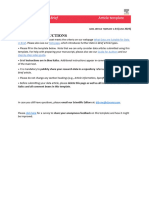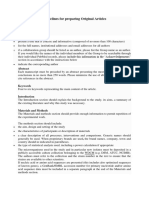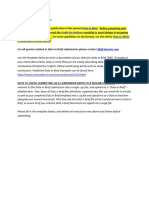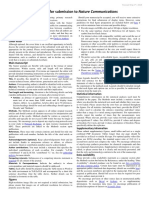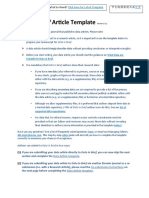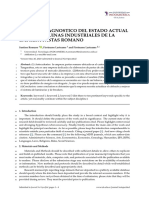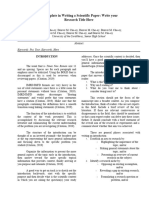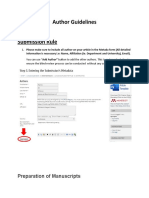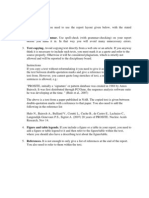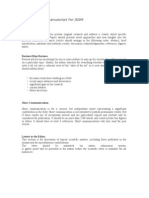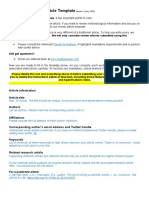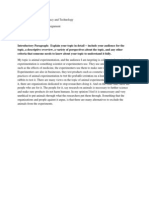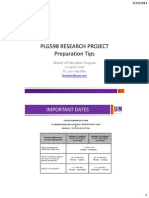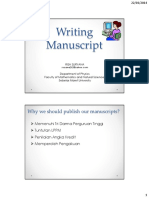------------------------------------------------------------------------------------------------------------------------------------------
October 2024
General guidelines
Please use this template to write your Data Note. Instructions are shown in blue and italic print.
● Follow the instructions and delete them before submitting your Data Note.
● You may add subheadings where appropriate to structure your Data Note but do not add or
delete any section headings.
● A Data Note is purely a description of data and should not contain any analyzed results,
discussions, interpretation of data or conclusions.
● Please aim to write the Data Note clearly in a way that it can be understood by a broad group of
scientists (non-specialists). Abbreviations and technical jargon should be minimized.
● Please ensure you have followed the template instructions, and your data have been deposited
in appropriate recommended data repositories (not attached as additional files). Your Data Note
must also include all the relevant declarations noted below (eg Data availability).
● Everything you need to complete the Data Note is available in this template. If you have any
queries when preparing your Data Note, please email the journal’s editorial office.
● Please adhere to the word limits noted in each section below.
● Apart from table 1, data notes must not contain any tables or figures. Instead, tables and figures
should be uploaded to the repository and be listed in table 1.
------------------------------------------------------------------------------------------------------------------------------------------
[Title]
The title should be a clear but concise description of the data the manuscript reports. It should be different to any
existing research paper.
[Author details]
List the full names and institutional addresses for all authors.
List the email addresses for only the corresponding author(s)
1
�Abstract
Please minimize the use of abbreviations and do not cite references in the abstract. The abstract must include the
following two sections:
Objectives:
The purpose and objective of the data presented. Answer the following question: Why was the data collected? If
the data is the side-product of a bigger study you should state this here. More detailed objectives can be included in
the main Objective section below.
Data description:
A brief description of the data. When writing this part, think about why your data might be useful and of value to
other researchers. A more detailed description can be included in the main Data description section below.
The abstract should not exceed 200 words.
Objective
The purpose and objective of the data presented. This is essentially the same as in the abstract but you can provide
more details here. Give the readers some background so they can put the data in context. If the data were never
published as part of a research paper, tell us why. We are looking for a brief and honest description of why the data
were collected. Please cite any related publications, e.g. research papers you have published that are based on the
same data.
This section should not exceed 300 words.
Important:
● Please do not provide a literature review. Authors can introduce the general topic in one or two sentences
and then cite relevant review articles for the interested reader.
● Have you or your collaborators published papers based on the same data or different data that came from
the same research project? If yes, then you must cite these. Papers under consideration should be
mentioned in the cover letter.
Suggestions to help you write this section:
● Provide a rationale for the research and collecting the data. Keep this brief and instead of a lengthy
description we encourage authors to cite sources that support their statement.
● Briefly (not more than one or two sentences) introduce the study/research project.
2
� ● If you have some thoughts on what the data can be used for or how it may help others, then do tell our
readers at the end of this section.
Data description
Briefly describe the data:
● What kind of data/data sets have you acquired?
● What do the data show? Provide a brief but informative description.
● Please provide details if the data were processed in any way (How were the data processed? Why were
the data processed?).
This section should be purely descriptive and not offer any interpretation of the data.
As part of the data description, you should describe key elements of the methodology (equipment used,
experimental setup). This does not need to be a detailed methodological description that allows reproducing the
data but key methodological information should be provided. A detailed description of the methodology must be
uploaded together with the data to the data repository that provides sufficient detail for other researchers to
reproduce the data.
Compulsory Table 1 below should provide an overview of all data files/data sets described in this Data Note.
Individual files (e.g. tables or figures) should be labeled data file 1, data file 2 and so on (the label does not
differentiate between tables, figures, code or other files). Larger collections of the same data type (e.g. a collection
of microscopy images) should be labeled data set 1, data set 2 and so on. Please refer to all data files and data sets
of table 1 within the data description. The data description should be concise and focus on the key information.
All data files/data sets need to be deposited in a recommended data repository.
This section should not exceed 500 words.
Table 1: Overview of data files/data sets.
Label Name of data file/data set File types Data repository and identifier (DOI
or accession number)
(file extension)
Data file 1 Name of data file 1 e.g. Matlab script file (.m) e.g. Figshare (copy DOI here)
Data file 2 Name of data file 2 e.g. MS Excel file (.xlsx) e.g. Figshare (copy DOI here)
Data set 1 Name of data set 1 e.g. Dicom files (.dcm) e.g. Dryad (copy accession no. here)
Please add as many rows as required. Files that are part of a larger collection should be summarized as a data set.
3
�Table 1 should provide the reader with an easy to digest overview of the files they expect to see when clicking
through to the data.
Some data repositories allow DOIs for individual files. The data files and data sets may all be part of one data
deposition and share the same DOI or have individual ones. The data may also be in different data repositories and
DOIs or accession numbers should be provided for each data file/data set listed in table 1.
Each data record needs to be included in the References, and cited from Table 1 and the Data Availability section.
Limitations
Clearly state the limitations of the data. This could be any shortcoming that occurred during data collection, small
sample sizes (which prevented the data to be used as part of a research paper) or outdated data among others. We
believe all sound data is valuable and deserves publication. Honest and transparent description of any limitations
will not affect editorial assessment. Limitations may be presented in bullet point format.
This section should not exceed 300 words.
Abbreviations
If abbreviations are used in the text they should be defined in the text at first use, and a list of abbreviations should
be provided here.
Declarations
All manuscripts must contain the following sections under the heading ‘Declarations’. More information on
declarations can be found in the journal submission guidelines in the editorial policies section.
Acknowledgments
Acknowledgments of people, grants, funds, etc. should be placed in a separate section on the title page. The names
of funding organizations should be written in full
Funding (information that explains whether and by whom the research was supported)
Author contributions
See the editorial policy section in the journal submission guidelines.
Competing interests (include appropriate disclosures)
4
�Ethics approval (only include this section if applicable to your manuscript)
Consent to participate (only include this section if applicable to your manuscript)
Consent to publish (only include this section if applicable to your manuscript)
Data availability
The data described in this Data Note can be freely and openly accessed on [Name of data
depository] under [Identifier, DOI, accession number etc.]. Please see table 1 and references
[Reference numbers] for details and links to the data.
Code availability (software application or custom code - if applicable)
References
All references, including URLs, must be numbered consecutively, in square brackets, in the order in which they are
cited in the text. The reference numbers must be finalized and the reference list fully formatted before submission.
Data records need to be included in the reference list, and cited from Table 1 and the Data availability section.
Format for citing a dataset with persistent identifier:
Zheng L-Y, Guo X-S, He B, Sun L-J, Peng Y, Dong S-S, et al. Genome data from sweet and grain sorghum (Sorghum
bicolor). GigaScience Database. 2011. http://dx.doi.org/10.5524/100012.
Please refer to the journal submission guidelines for details on how to cite other publication types.


